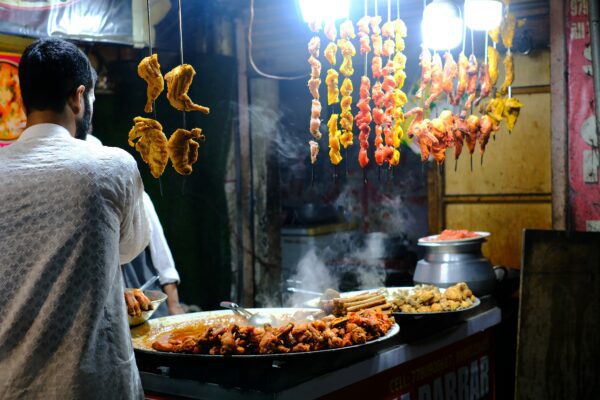Traveling to India promises an experience filled with vibrant culture, rich history, and stunning landscapes. Whether you’re exploring the bustling streets of Delhi, marveling at the majestic Taj Mahal in Agra, or savoring the flavors of authentic street food, India offers a diverse sensory journey. As you plan your trip, it’s essential to learn about India travel tips and cultural nuances to ensure a smooth trip.
Understanding local customs like greeting with a “namaste” and being cautious about food safety can make your adventure more enjoyable. Consider exploring off-the-beaten-path destinations such as the backwaters of Kerala or experiencing the spiritual aura of the Ganges River in Varanasi. When packing, remember that the best time to tour India varies by region.
Some of the links in this article may be affiliate links, which means we may receive a small commission, at no additional cost to you if you decide to purchase through one of our recommended partners. As a reminder, here at Yonder, we thoroughly curate the products we offer and only recommend plans and services we trust and believe bring value to our readers and customers.
Key Takeaways
- India offers diverse experiences from vibrant cities to tranquil backwaters.
- Understanding local customs and food tips enhances your trip.
- Choose travel times wisely to make the most of India’s best destinations.
Jumping Ahead
 Is it safe to travel to India now from the USA?
Is it safe to travel to India now from the USA?
Travel safety is of utmost importance when visiting international destinations, including India. However, the U.S. Department of State suggests being extra cautious when traveling in India due to issues like crime and terrorism.
Consequently, there are regions you might want to leave off your itinerary, such as Jammu and Kashmir. Although areas like the Ladakh region and its capital, Leh, are relatively safe. These areas pose significant risks related to terrorism and civil unrest, and you can find more details in the India Travel Advisory.
 Safety Tips for Traveling in India
Safety Tips for Traveling in India
Traveling in India can be an unforgettable experience, full of vibrant colors, diverse cultures, and incredible history. To make the most of your trip while staying safe, consider the following helpful tips.
Stay Alert and Trust Your Instincts
It’s vital to stay aware of your surroundings. If something feels off, trust your instincts and leave the area. Use apps like Google Maps for navigation, but always watch out for your personal safety.
Transportation Safety
When hiring taxis or auto rickshaws, stick with trusted services like Ola or Uber. These options have GPS tracking for extra safety. Further, if taking the train, keep your belongings close, especially in crowded stations. The Indian railway system is extensive, connecting major cities and remote regions across the country, making it an efficient and cost-effective way to travel.
Blend In with Your Clothing
Dressing respectfully is not just about comfort but also safety. Wear modest clothing that covers your shoulders and knees. This will help you feel more at ease and avert unwanted attention. In addition, many temples, mosques, and other sacred sites require visitors to cover their shoulders and knees as a sign of reverence.
Prefer Daytime Travel Over Night
While some areas are safe at night, it’s generally better to travel during daylight, especially if you’re exploring new places. While many urban areas have improved in terms of safety, nighttime travel can pose risks such as reduced visibility and increased chances of encountering crime. Additionally, access to reliable transportation during nighttime in India is limited. If you must go out after dark, stay in well-lit and busy areas.
Choose the Right Accommodation
Pick accommodations known for their security. Look for places with good reviews highlighting the safety and hospitality of the staff. It’s also generally wise to use a hotel safe for valuable items when out and about.
Avoid Risky Areas
Some places may be riskier than others. Research and bypass areas known for safety issues, opting instead for popular tourist spots where you’ll usually find good security and guidance. Some common areas to avoid due to conflicts, violence, unsafe infrastructure, and crime include:
- Regions affected by Naxalite insurgency
- Some Areas of Uttar Pradesh
- Certain Districts in Bihar
Stay Connected
Keep in touch with someone back home and share your travel itinerary. Regular updates assure them of your safety. Consider carrying a portable charger to ensure your phone is always powered. For extra security, register your trip with the Smart Traveler Enrollment Program. It’s free and connects you to assistance if you’re faced with an emergency abroad.
 Are Certain Vaccinations Required to Enter India?
Are Certain Vaccinations Required to Enter India?
For most American residents departing their trip from the US, there aren’t mandatory vaccinations required to enter India. There are a few exceptions, so be sure to read the CDC India traveler’s health page for more information on guidelines and recommendations.
 Is India a Family-Friendly Destination?
Is India a Family-Friendly Destination?
Traveling to India with young children can be a bit challenging due to the busy streets and crowds. Despite this, the experience can be something your family creates special memories from.
Family-Friendly Accommodations in India
To make your trip easier, consider staying in regions like Jaipur and Kerala, where family-friendly accommodations are available.
Best Family Hotels in Jaipur, India
Family-Friendly Hotels in Kerala (With Fully Refundable Options)
Family-Friendly Activities in India
For activities, you might explore the enchanting wonders of the Taj Mahal or take part in small group tours in India for a safer and more guided experience. Here are a few of our favorites:
Explore Jaipur’s Amer Fort: Take an elephant ride or a jeep to the fort, where kids can see the stunning architecture and panoramic views. The fort also has a light and sound show that narrates its history.
Wildlife Safari in Ranthambore National Park: Embark on a thrilling jeep safari to spot tigers and other wildlife. Kids will love the adventure of seeing animals in their natural habitat.
KidZania (Mumbai): This interactive theme park allows children to role-play various professions in a mini-city. It’s both fun and educational, providing a unique experience for kids.
 Best Time to Visit India
Best Time to Visit India
Choosing when to travel to India can greatly affect your experience. The country’s vast size and varied climate mean there’s no single best time for every destination.
Winter (December to February)
This is when the weather is most pleasant in much of India. Think cool breezes and clear skies. It’s a great time to tour popular destinations like Delhi, Agra, and Rajasthan. However, in the northern regions, like the Himalayas, it can get quite cold.
Spring (March to early April)
As temperatures start to rise, it’s still a good period to explore. You might find vibrant festivals and blooming flowers, especially in more temperate areas. It’s also a perfect season to see places like Kerala or Goa.
Summer (April to June)
It gets really hot during these months, especially in the central and northern parts. If you’re traveling during this time, head to the hill stations or cooler regions in the north.
Monsoon (June to September)
The rains bring lush landscapes, but they can also make travel challenging. Road conditions might be difficult, and some regions might experience floods. Still, if you love the monsoon vibe, places like Kerala offer beautiful scenery during these months.
 Top Destinations in India
Top Destinations in India
When planning a trip to India, you’ll find a variety of places to explore, each offering something special. Here’s a list of must-see destinations you might want to consider:
History and Culture
Taj Mahal, Agra: A symbol of love and architectural wonder, the Taj Mahal is a stunning sight. Its white marble beauty and rich history make it an essential part of any Indian travel adventure.
Jaipur, Rajasthan: Known as the Pink City, Jaipur is famous for its charming palaces and lively markets. Be sure to include the Amber Fort and experience the local culture and cuisine to your trip.
Varanasi, Uttar Pradesh: One of the oldest cities in the world, Varanasi is full of spiritual energy. Experience the Ganges River rituals and immerse yourself in the city’s deep spirituality.
Diverse Experiences
Mumbai, Maharashtra: Dive into the bustle of Mumbai, where Bollywood glamour meets historical landmarks. Don’t miss the Gateway of India and be sure to take part in the local street food scene.
Delhi: The capital city is a mix of the old and new. Explore historical sites like the Red Fort and lively markets, along with modern attractions and eateries.
Udaipur, Rajasthan: Known as the City of Lakes, Udaipur offers romantic boat rides and stunning palaces, including the famous City Palace overlooking Lake Pichola.
Nature and Adventure
Kerala’s Backwaters: The backwaters of Kerala provide serenity and picturesque scenery. You can enjoy a houseboat ride on the peaceful waters and watch the world go by.
Goa’s Beaches: For a laid-back vibe, Goa offers sun-drenched beaches and vibrant nightlife. Whether you see the lively North Goa or the serene South Goa, relaxation is a guarantee.
Leh-Ladakh: If you’re an adventure seeker, the rugged landscapes of Leh-Ladakh are perfect for trekking and exploring beautiful monasteries nestled in the mountains.
Western Ghats: A UNESCO World Heritage Site and stunning mountain range along India’s western coast. It’s known for its breathtaking landscapes and rich biodiversity. Fun features include tea plantations and unique species found nowhere else on Earth.
 Insurance for Traveling to India
Insurance for Traveling to India
Getting travel insurance for your trip to India can provide you with peace of mind, even if it’s not required. If you need to cancel or interrupt your travel plans, insurance can help you get back the money you spent on airfare, hotels, and accommodations. Travel insurance can also cover your medical costs if you get sick or injured during your trip. Trust us, it happens more often than you think! Opt for a policy that has at least $100,000 per person for medical expenses.
How to Get the Best Travel Insurance for India
Our travel insurance experts recommend a comprehensive travel insurance policy for trips to India. When using Yonder, you can use filters for popular benefits or other coverage you need. One of the most unique ways to shop for travel insurance policies is by travel style. This way, you can get coverage curated for the type of trip you’re taking.
If you’ve never purchased travel insurance before, Yonder Travel Insurance makes it really simple. The online quoting and purchasing of a policy can take just minutes! And if you need assistance, our team of friendly humans can help recommend a policy.
 Helpful Tips for Your First Trip to India
Helpful Tips for Your First Trip to India
Travel Advice for Moving Around India
Traveling around India can seem overwhelming due to its size and crowded cities. Consider taking trains, which are a convenient and affordable way to cover large distances. Make sure to book your tickets in advance, especially for long journeys. Auto-rickshaws are handy for short distances, but remember to agree on the fare before starting your journey. App-based taxis like Uber and Ola also provide a reliable option in many cities.
Safety Tips for Eating in India
Indian cuisine is delicious and full of flavors, but you’ll want to avoid some things and be a little cautious. Opt for freshly cooked food from places that are popular and busy. Bottled water is a must, and avoid using tap water for things like brushing your teeth. Don’t be deterred from trying street vendor food, but stick with vendors who have a good reputation for cleanliness.
Tips for Exploring Indian Cities
Navigating Indian cities can be tricky due to their bustling nature and traffic. Downloading offline maps can make it easier for you to find your way, even without an internet connection. When exploring crowded markets, hold on to your belongings tightly and be aware of your surroundings. It’s also beneficial to have a local SIM card for easy communication and access to navigation apps.
 Cultural Tips for Touring India
Cultural Tips for Touring India
A trip to India promises an exhilarating adventure brimming with vibrant experiences, rich traditions, and a kaleidoscope of diverse cultures waiting to be explored! However, India might present culture shock to many first-time visitors. To make the most of your journey and interact respectfully with locals, it’s useful to keep a few cultural tips in mind.
Dress Modestly
When taking a trip to India, it’s important to wear modest clothing. That way, you can fend off unwanted attention and show respect for local customs. Loose and light clothing will keep you comfortable in the heat.
Take Your Shoes Off
In many Indian homes and some businesses, removing your shoes before entering is customary. It shows respect to the hosts and keeps indoor spaces clean. Always follow this ritual unless told otherwise.
Learn Basic Phrases
While many people in India speak English, learning a few basic phrases in Hindi or the regional language can be beneficial for you and appreciated by locals. Simple greetings and thank-yous can go a long way in building connections and respect from the locals.
Respect Religious Practices
India is home to diverse religions and spiritual practices. If you tour a temple or a religious site, be mindful of the traditions and dress codes. For example, some place-specific rituals like wearing head coverings or not taking photos can be important.
Be Open to New Experiences
Whether it’s joining a cooking class in a bustling market, sharing stories over chai with a family in a rural village, or learning traditional dance in a cultural workshop, these interactions can deeply enrich your journey.
Embrace the distinct practices and traditions of each region—be it the colorful festivals of Rajasthan or the serene rituals along the Ganges. It’s also okay to set clear boundaries on what you’re comfortable with.
Be Mindful of Etiquette
In interactions, using the right hand is considered polite for giving or receiving items. Pay attention to body language, as gestures can have different meanings, so it’s better to observe and mirror local customs.
 Frequently Asked Questions
Frequently Asked Questions
What should you bring for your first journey to India? Packing for India can be an adventure in itself! Consider lightweight, breathable clothing to stay comfortable in the heat. Scarves or shawls are handy for visiting temples or mosques. Don’t forget a universal power adapter for your electronics. Packing a first-aid kit and some over-the-counter medications can be useful as well. Check out Yonder’s international travel packing checklist.
Which places are essential for first-time travelers to India? India is full of must-see spots. The Taj Mahal in Agra is a stunning destination. Jaipur, known as the Pink City, is famous for its palaces and forts. In the south, you might like Kerala’s beautiful backwaters. In the north, the city of Varanasi is incredible for its spiritual atmosphere.
How can you ensure your safety while exploring India? Staying safe in India is all about being aware. Keep your belongings close and avoid isolated areas at night. It’s smart to carry a copy of your identification and emergency contacts. When negotiating with rickshaw or taxi drivers, settling on a price before your trip starts can prevent misunderstandings.
What are some cultural etiquette tips for travelers to India? Respecting local traditions will enrich your experience. Dress modestly, especially in rural areas and religious sites. It’s polite to remove your shoes before entering someone’s home or a place of worship. Using your right hand for eating or passing objects is also considered respectful.
What are the recent travel guidelines for international travelers to India? Staying up-to-date with travel guidelines is crucial. Ensure you have a valid visa, which can now be applied for online. At the airport, you might need to show proof of accommodation or return tickets. Check for any health advisories or vaccination requirements before departing.
How can you handle common travel challenges in India? Traveling in India comes with its own set of challenges, like language barriers and crowded public transport. Learning a few basic phrases in Hindi or the local language can make communication less difficult. Being patient, especially in busy areas, can make your trip more enjoyable. Try to plan for some flexibility in your schedule to accommodate unexpected delays.
As a seasoned professional with over seven years of experience in the travel insurance industry, Meagan has honed her expertise in marketing and operations working for Yonder Travel Insurance.
Throughout her career, she's shown dedication assisting customers at every stage of their travel insurance journey, from the initial quote process to navigating the claims process. Her expert understanding of travel insurance equips her to provide unbiased and valuable insights, which help travelers find the best coverage and maximize its benefits.
Tags: travel safety


 Is it safe to travel to India now from the USA?
Is it safe to travel to India now from the USA?

























